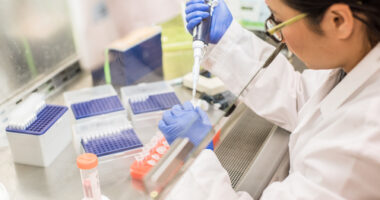Certain stem cells may offer benefits for DMD treatment: Early study
Human amnion-derived cells found to preserve muscle function in mouse model

Stem cells derived from the amniotic membrane of pregnant women after childbirth “could provide therapeutic benefits” for people with Duchenne muscular dystrophy (DMD), according to researchers in Japan.
These stem cells, known as human mesenchymal stromal cells, were able to delay DMD progression and preserve muscle function in a mouse model of the disease.
Mesenchymal stromal/stem cells (MSCs) derive from various tissues and are capable of differentiating into several cell types. They can modulate the immune system and suppress the activation of immune cells.
Human amnion-derived MSCs (hAMSCs) are obtained from the amnion, the innermost membrane that surrounds an embryo.
“MSCs may be attractive candidates for cell-based strategies for diseases characterized by acute and chronic inflammation,” according to researchers.
The study, “Immunomodulatory amnion-derived mesenchymal stromal cells preserve muscle function in a mouse model of Duchenne muscular dystrophy,” was published in the journal Stem Cell Research & Therapy.
Cell therapy approaches face challenges in DMD
DMD is caused by mutations in the DMD gene, which provides instructions to produce dystrophin, a critical protein for muscle health. The disease is characterized by progressive muscle weakness and wasting. It can also affect the heart and muscles in the chest required for breathing.
Research into cell therapy approaches for muscle recovery in DMD is ongoing. However, the applicability of such therapies is challenging due to poor cell survival, and difficulties with whole-body muscle delivery.
In this study, researchers in Japan used hAMSCs obtained from pregnant women who underwent a cesarean delivery, with informed consent. This is a cell source with unique features, such as a non-invasive collection procedure, ethical acceptability, and minimal risk of immune reaction and cancer, according to the scientists.
“We hypothesized that the anti-inflammatory properties of hAMSCs could ameliorate [ease] the dysfunction of dystrophic muscle and delay disease progression,” they wrote.
To test that hypothesis, the researchers analyzed in the lab how isolated hAMSCs modulated the immune system.
When hAMSCs were cultured with peripheral blood mononuclear cells — which include several types of blood cells — they were able to increase the expression of anti-inflammatory markers in macrophages.
Macrophages are a type of immune cell that surrounds and kills microorganisms, removes dead cells, and stimulates the activity of other immune cells. They can acquire a profile where they induce inflammation, called M1, or an anti-inflammatory and wound-healing profile known as M2.
This hAMSC treatment strategy could offer therapeutic benefits for patients with DMD.
Disease markers were reduced after injections
To examine the effect of hAMSCs on a DMD mouse model (called mdx), the cells were injected into the tail vein of the mice (four or six injections, weekly) during the acute phase of the disease, beginning at 4-5 weeks of age. Mice not treated with the cells were used as controls.
After the injections, there was a temporary reduction of the blood levels of creatine kinase — a marker of muscle damage and heart attack. Levels of interleukin-6, a pro-inflammatory signaling molecule, were decreased relative to untreated mice.
Moreover, mice given hAMSCs also showed little muscle infiltration by immune cells, in both a leg muscle and the diaphragm. Muscle fiber regeneration was also observed.
These effects were associated with a shift of macrophages toward the anti-inflammatory profile. However, muscle dystrophin was not detected in mice treated with hAMSCs, “suggesting that hAMSCs did not recover dystrophin expression,” the researchers wrote.
Treated mice show improvement in muscle function, running endurance
During long-term experiments, hAMSCs were associated with an improvement in muscle function in the mouse model compared to non-treated mice, as revealed by assessing grip strength.
Mice receiving hAMSCs also enhanced their running endurance, meaning how long they could run per minute, as tested with a computerized wheel system.
“Collectively, these findings indicated that … hAMSC administration delayed the progression of muscle dysfunction in mdx mice, as the locomotor activity of hAMSC-treated mice was maintained until the mice were 12 months old,” the researchers wrote.
Treatment with hAMSCs also attenuated inflammation of the heart muscle, and improved the function of the left ventricle, compared with non-treated mice.
“The immunosuppressive properties of hAMSCs associated with M2 macrophage polarization [shift] might account for the therapeutic effects,” the researchers concluded. “This hAMSC treatment strategy could offer therapeutic benefits for patients with DMD.”








